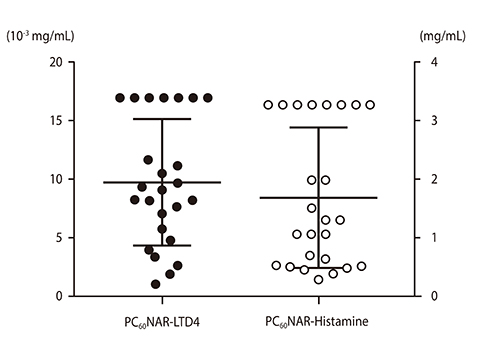Asia Pac Allergy.
2016 Oct;6(4):245-252. 10.5415/apallergy.2016.6.4.245.
Correlations of nasal responses to leukotriene D4 and histamine nasal provocation with quality of life in allergic rhinitis
- Affiliations
-
- 1State Key Laboratory of Respiratory Disease, National Clinical Research Center of Respiratory Disease, First Affiliated Hospital of Guangzhou Medical University, Guangzhou 510120, China. jpzhenggy@163.com
- KMID: 2397021
- DOI: http://doi.org/10.5415/apallergy.2016.6.4.245
Abstract
- BACKGROUND
The symptoms of allergic rhinitis (AR) greatly affect the quality of life (QoL) in the patients with AR. The correlations of nasal response to leukotriene D4 (LTD4) and histamine nasal provocation with health related QoL in AR are not clear.
OBJECTIVE
To evaluate the correlations of nasal response to LTD4 and histamine nasal challenge with QoL in AR.
METHODS
Patients randomly underwent LTD4 and histamine nasal challenge tests, completed the rhinoconjunctivitis quality of life questionnaire (RQoLQ), and rating the symptom severity score (total symptom score 4, TSS4) in the previous week. The correlations between nasal challenge tests induced nasal responses and QoL in RQoLQ were analyzed.
RESULTS
A total of 25 eligible AR patients enrolled and finished both LTD4 and histamine nasal challenge and completed the questionnaire of RQoLQ. Histamine nasal challenge induced sneezing, increased nasal resistant were correlated with most of the dimensions (general, practical, nasal, eye problems, and quality of sleep, p < 0.05), while LTD4 nasal challenge induced sneeze, increased nasal resistant only correlated with nasal and ocular problems. On the contrary, the severity of the sneeze assessed by TSS4, was not correlated with QoL, while the severity of rhinorrhea, congestion, and nasal pruritus were correlated with nasal and practical problems, and nasal congestion was also correlated with ocular problems (r = 0.60, p = 0.01).
CONCLUSION
LTD4 and histamine nasal challenge induced nasal responses were correlated with different clinical symptoms severity and QoL, which can be used as a good diagnosis and evaluation methods for the management of AR.
Keyword
MeSH Terms
Figure
Cited by 1 articles
-
Greetings from Asia Pacific Allergy
Yoon-Seok Chang
Asia Pac Allergy. 2016;6(4):195-197. doi: 10.5415/apallergy.2016.6.4.195.
Reference
-
1. Meltzer EO, Blaiss MS, Naclerio RM, Stoloff SW, Derebery MJ, Nelson HS, Boyle JM, Wingertzahn MA. Burden of allergic rhinitis: allergies in America, Latin America, and Asia-Pacific adult surveys. Allergy Asthma Proc. 2012; 33:Suppl 1. S113–S141.
Article2. Spector SL. Overview of comorbid associations of allergic rhinitis. J Allergy Clin Immunol. 1997; 99:S773–S780.
Article3. Passali D, Mösges R, Hassan HA, Bellusi L. Working Group. International Conference on Allergic Rhinitis in Childhood. Allergy. 1999; Suppl 55. 7–34.
Article4. Juniper EF, Guyatt GH, Willan A, Griffith LE. Determining a minimal important change in a disease-specific Quality of Life Questionnaire. J Clin Epidemiol. 1994; 47:81–87.
Article5. de Graaf-in 't Veld T, Koenders S, Garrelds IM, Gerth van. The relationships between nasal hyperreactivity, quality of life, and nasal symptoms in patients with perennial allergic rhinitis. J Allergy Clin Immunol. 1996; 98:508–513.6. Bonini S, Rasi G, Brusasco V, Carlsen KH, Crimi E, Popov T, Schultze-Werninghaus G, Gramiccioni C, Bonini M, Passali D, Bachert C, van Cauwenberge PB, Bresciani M, Bonini S, Calonge M, Montan PG, Serapiao Dos Santos M, Belfort R Jr, Lambiase A, Sacchetti M. Nonspecific provocation of target organs in allergic diseases: EAACIGA(2)LEN consensus report. Allergy. 2007; 62:683–694.
Article7. Vaidyanathan S, Williamson P, Clearie K, Morrison A, Lipworth B. Nasal AMP and histamine challenge within and outside the pollen season in patients with seasonal allergic rhinitis. J Allergy Clin Immunol. 2011; 127:173–178.8. Litvyakova LI, Baraniuk JN. Nasal provocation testing: a review. Ann Allergy Asthma Immunol. 2001; 86:355–364.
Article9. Meltzer EO. Quality of life in adults and children with allergic rhinitis. J Allergy Clin Immunol. 2001; 108:1 Suppl. S45–S53.
Article10. Riechelmann H, Bachert C, Goldschmidt O, Hauswald B, Klimek L, Schlenter WW, Tasman AJ, Wagenmann M. German Society for Allergology and Clinical Immunology (ENT Section). Working Team for Clinical Immunology. Application of the nasal provocation test on diseases of the upper airways. Position paper of the German Society for Allergology and Clinical Immunology (ENT Section) in cooperation with the Working Team for Clinical Immunology. Laryngorhinootologie. 2003; 82:183–188.11. Clement PA, Gordts F. Standardisation Committee on Objective Assessment of the Nasal Airway, IRS, and ERS. Consensus report on acoustic rhinometry and rhinomanometry. Rhinology. 2005; 43:169–179.12. Bisgaard H, Olsson P, Bende M. Effect of leukotriene D4 on nasal mucosal blood flow, nasal airway resistance and nasal secretion in humans. Clin Allergy. 1986; 16:289–297.
Article13. Miadonna A, Tedeschi A, Leggieri E, Lorini M, Folco G, Sala A, Qualizza R, Froldi M, Zanussi C. Behavior and clinical relevance of histamine and leukotrienes C4 and B4 in grass pollen-induced rhinitis. Am Rev Respir Dis. 1987; 136:357–362.14. Howarth PH. Mediators of nasal blockage in allergic rhinitis. Allergy. 1997; 52:40 Suppl. 12–18.15. Bousquet PJ, Demoly P, Devillier P, Mesbah K, Bousquet J. Impact of allergic rhinitis symptoms on quality of life in primary care. Int Arch Allergy Immunol. 2013; 160:393–400.
Article16. Corey JP, Houser SM, Ng BA. Nasal congestion: a review of its etiology, evaluation, and treatment. Ear Nose Throat J. 2000; 79:690–693.
Article17. Jessen M, Malm L. Definition, prevalence and development of nasal obstruction. Allergy. 1997; 52:40 Suppl. 3–6.
Article18. van Spronsen E, Ingels KJ, Jansen AH, Graamans K, Fokkens WJ. Evidence-based recommendations regarding the differential diagnosis and assessment of nasal congestion: using the new GRADE system. Allergy. 2008; 63:820–833.
Article19. Demoly P, Bousquet PJ, Mesbah K, Bousquet J, Devillier P. Visual analogue scale in patients treated for allergic rhinitis: an observational prospective study in primary care: asthma and rhinitis. Clin Exp Allergy. 2013; 43:881–888.20. Bielory L. Allergic conjunctivitis and the impact of allergic rhinitis. Curr Allergy Asthma Rep. 2010; 10:122–134.
Article21. Cibella F, Ferrante G, Cuttitta G, Bucchieri S, Melis MR, La Grutta S, Viegi G. The burden of rhinitis and rhinoconjunctivitis in adolescents. Allergy Asthma Immunol Res. 2015; 7:44–50.
Article


